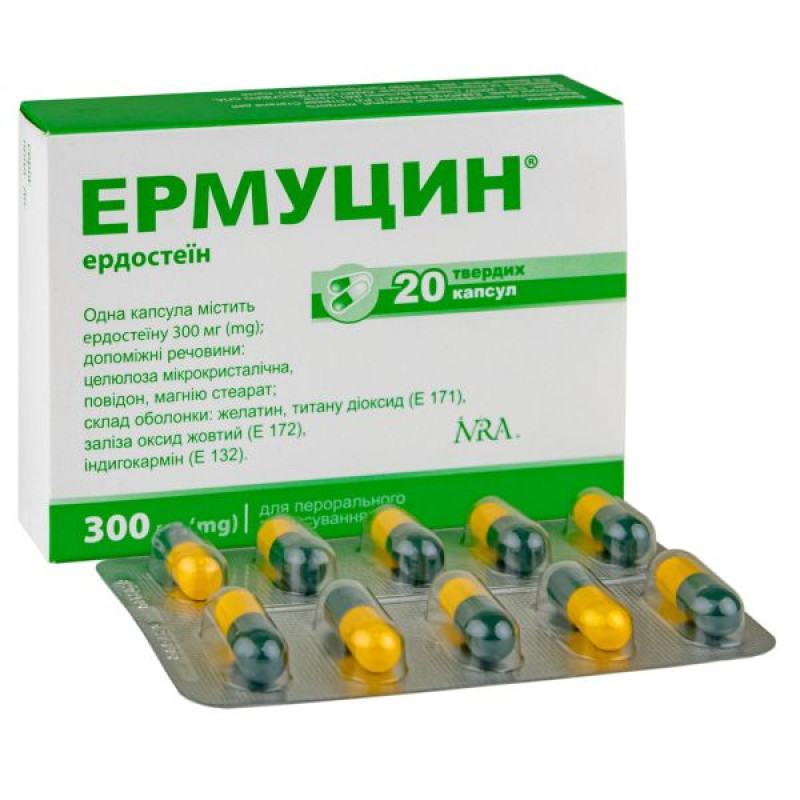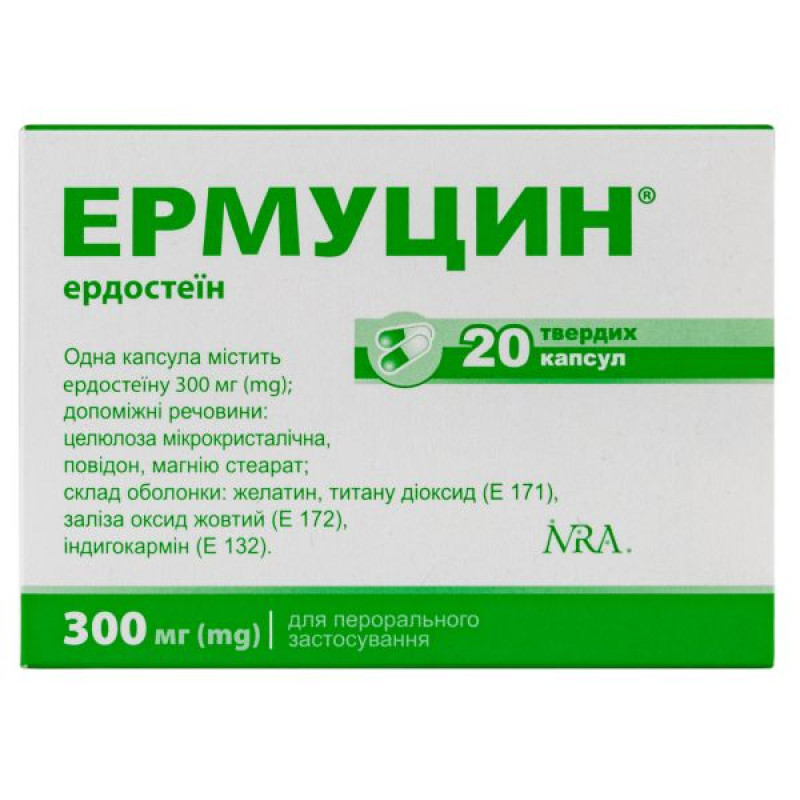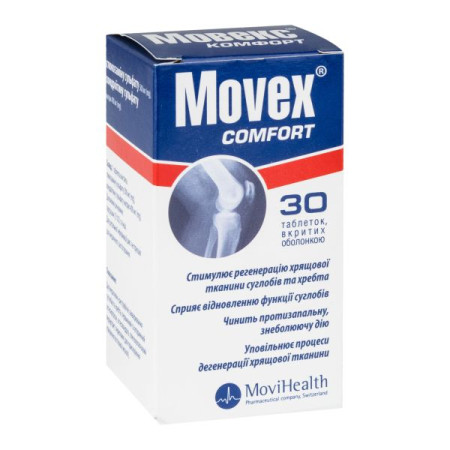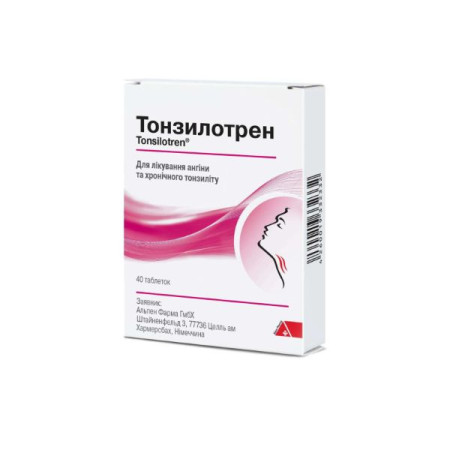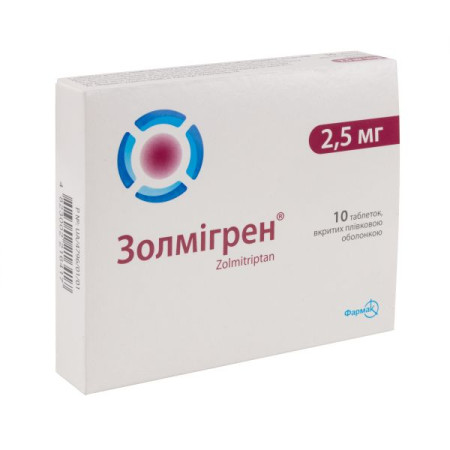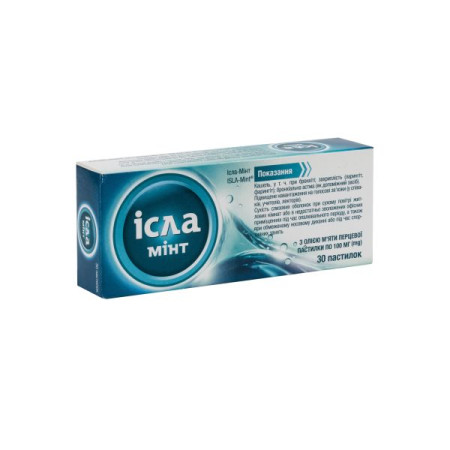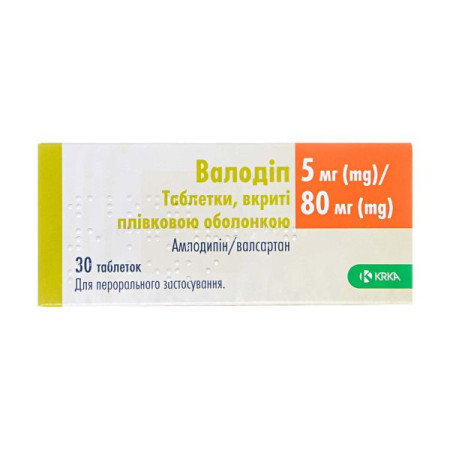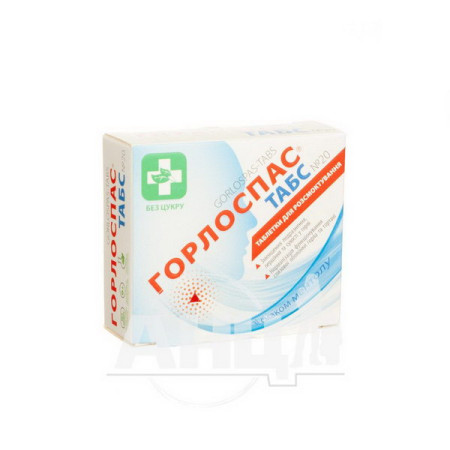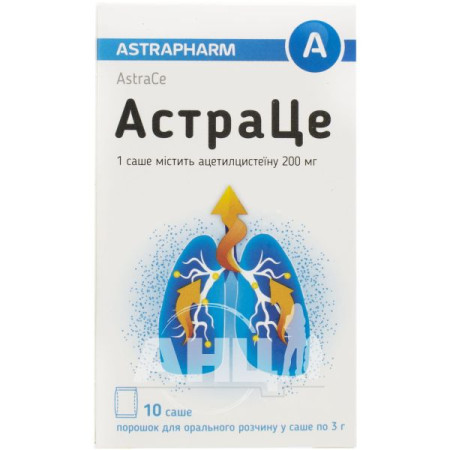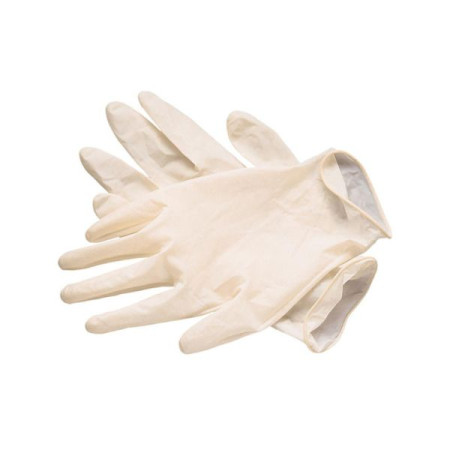Ermucin hard capsules 300 mg blister No. 20
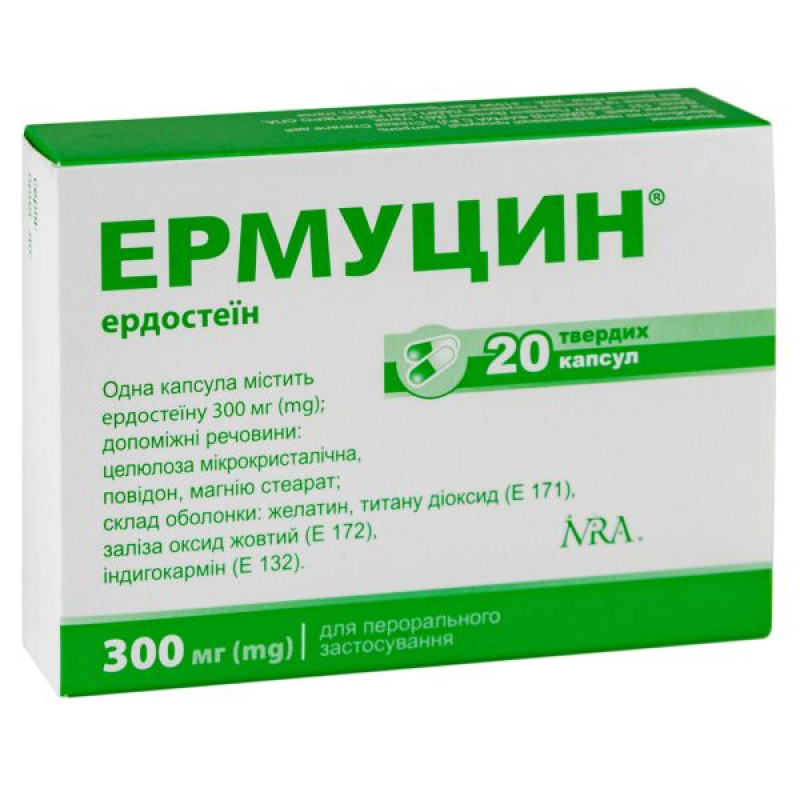
Instructions for Ermucin hard capsules 300 mg blister No. 20
Composition
active ingredient: erdosteine;
1 capsule contains: erdosteine 300 mg;
excipients: microcrystalline cellulose, povidone, magnesium stearate;
shell composition: gelatin, titanium dioxide (E 171), iron oxide yellow (E 172), indigo carmine (E 132).
Dosage form
Hard capsules.
Main physicochemical properties: gelatin capsules with a yellow body and a green cap, containing a white to almost white powder.
Pharmacotherapeutic group
Mucolytics. ATX code R05CB15.
Pharmacological properties
Pharmacodynamics.
Erdosteine is a mucolytic compound whose action is mediated by its active metabolites. These metabolites have free thiol groups that cause the destruction of disulfide bridges that bind glycoprotein fibers, and thus reduce the elasticity and viscosity of mucus. As a result, the drug helps to clear the respiratory tract of secretions and increases the efficiency of the mucociliary mechanism in removing mucus and mucopurulent secretions from the upper and lower respiratory tract.
Erdosteine also reduces the adhesive ability of Gram-positive and Gram-negative bacteria to the respiratory epithelium. As a result of this antibacterial anti-adhesive effect, which has been proven in in vitro studies, bacterial colonization of the respiratory tract may be reduced and the risk of bacterial superinfection may be reduced.
Erdosteine also acts as an acceptor of free oxygen radicals, prevents their formation locally and significantly reduces the level of 8-isoprostane as a marker of lipid peroxidation. The anti-inflammatory effect of erdosteine in vitro and in vivo was also indicated by a decrease in the synthesis of some pro-inflammatory cytokines (IL-6, IL-8).
Erdosteine prevents the inhibition of alpha-1-antitrypsin by tobacco smoke, thus preventing damage caused by smog or tobacco smoking.
Moreover, erdosteine increases the concentration of IgA in the airways of patients with chronic obstructive pulmonary disease (COPD) and prevents the inhibition of granulocytes caused by smoking. Erdosteine also increases the concentration of amoxicillin in bronchial secretions, and thus the therapeutic effect of the simultaneous use of these agents will be faster compared to the therapeutic effect of amoxicillin monotherapy. In patients with COPD, erdosteine therapy for 8 months reduced the frequency of exacerbations and improved the quality of life.
The effect of the drug is manifested approximately 3-4 days after the start of therapy. Erdosteine itself does not contain free SH-radicals, therefore it has a very slight effect on the gastrointestinal tract (GI) at recommended doses, and the profile of adverse events from the GI tract when using it does not differ from that when using placebo.
Pharmacokinetics.
Erdosteine is rapidly absorbed; metabolized by the liver to at least 3 active metabolites, the most abundant (in percentage) and active of which is N-thiodiglycolylhomocysteine (metabolite 1, or M1). Main pharmacokinetic parameters (for M1): Cmax: 3.46 μg/ml; Tmax: 1.48 hours; AUC (0-24 hours): 12.09 mg/l/h. The level of binding of erdosteine to plasma proteins is 64.5%. Elimination occurs through urine and feces, where only inorganic sulfates were detected.
The elimination half-life (for the product as a whole, i.e. for erdosteine and its metabolites) is more than 5 hours. Repeated administration and food intake do not alter the pharmacokinetic profile of the product. No signs of cumulation or enzyme induction were observed.
In cases of impaired liver function, an increase in Cmax and AUC values was observed.
In addition, in severe liver dysfunction, an increase in the half-life of the drug has been observed. In severe renal failure, there is a risk of accumulation of metabolites.
Indication
Reducing the viscosity and facilitating expectoration of bronchial secretions in the treatment of acute and chronic diseases of the upper and lower respiratory tract, such as bronchitis, rhinitis, sinusitis, laryngopharyngitis, exacerbation of chronic bronchitis, chronic obstructive pulmonary disease (COPD), hypersecretory bronchial asthma, bronchiectasis.
Prevention of recurrent episodes of infections and complications after surgical interventions, such as pneumonia or partial atelectasis of the lungs.
This drug is also indicated as concomitant therapy with antibiotics in case of bacterial respiratory tract infections.
Contraindication
Hypersensitivity to the active substance or to any of the excipients containing free SH groups.
You should stop using this medicine in the following cases:
- with liver disorders (for example, with increased levels of alkaline phosphatase or transaminases in the blood serum);
- with renal failure (creatinine clearance < 25 ml/min);
- in homocystinuria (this drug is a source of homocysteine, and there are currently no data available on the use of erdosteine in cases of congenital disorders of amino acid metabolism, especially in patients who are forced to follow a methionine-free diet);
- with peptic ulcer disease in the active phase.
Interaction with other medicinal products and other types of interactions
No undesirable interactions with other drugs commonly used in respiratory tract infections and COPD, such as theophylline, bronchodilators, erythromycin, amoxicillin or sulfamethoprim, have been observed. Erdosteine potentiates the effect of some antibiotics (e.g. amoxicillin, clarithromycin) that may be used therapeutically. A synergistic effect of erdosteine has been demonstrated when used concomitantly with budesonide and salbutamol.
Application features
If classic symptoms of hypersensitivity appear, erdosteine therapy should be discontinued immediately.
The simultaneous use of antitussives is inappropriate and may cause accumulation of secretions in the bronchial tree, increasing the risk of developing superinfection or bronchospasm.
Use during pregnancy or breastfeeding
No cases of embryo/fetal malformations were observed in preclinical studies, however, information on the use of erdosteine during pregnancy and lactation is limited. Therefore, this drug should be used during pregnancy, especially during the first trimester, only if clearly needed, after assessing the benefit/risk to the fetus and mother.
Ability to influence reaction speed when driving vehicles or other mechanisms
No negative effects on the ability to drive, operate other mechanisms, or concentrate were observed.
Method of administration and doses
The drug Erdomed is intended for use by adults in the amount of 1 capsule (300 mg) 2 times a day. Treatment can last up to 10 days.
Hard capsules are intended for direct oral administration.
Children
This dosage form is not used in children.
Overdose
No cases of overdose have been reported so far.
In case of overdose or accidental ingestion of this drug by a child, symptomatic therapy (gastric lavage and other supportive measures) is recommended.
Adverse reactions
Sometimes the use of erdosteine can cause undesirable reactions from the gastrointestinal tract, such as a burning sensation and pain in the stomach, nausea, vomiting and, rarely, diarrhea. In several cases, ageusia or dysgeusia were observed at the beginning of therapy. Hypersensitivity reactions, such as skin rashes or unexpected hyperpyrexia, erythema, Quincke's edema, occur rarely. From the nervous system, headache is possible.
Expiration date
5 years.
Storage conditions
Store at a temperature not exceeding 25°C.
Packaging
10 capsules in an aluminum/PVC/PVDC blister; 2 or 6 blisters in a cardboard box.
Vacation category
According to the recipe.
Manufacturer/Applicant
Angelini Pharma Czech Republic s.r.o., Czech Republic.
Location of the manufacturer and its business address/location of the applicant
Paterny 1216/7, 635 00 Brno, Czech Republic.
There are no reviews for this product.
There are no reviews for this product, be the first to leave your review.
No questions about this product, be the first and ask your question.







